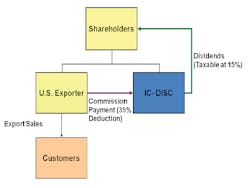Tax-aggedon' Hits Manufacturers Below the Belt
The “Fiscal Cliff”. “Tax-aggedon”. Two colorful terms that are being bandied around in the business and popular press to express the unknown future of many tax breaks on which people and businesses have come to rely. There is one long-standing tax tool wrapped up in “tax-aggedon” that specifically impacts manufacturers, DISCs, or Domestic International Sales Corporation, which currently are tax-exempt entities.
On January 1, 2013, the official expiration mark of Bush tax cuts, the use of DISCs may no longer be a tax-effective structure for manufacturers who are exporting. The financial implications of DISCs no longer being around are significant. For example, let’s say a manufacturer has $10 million in annual revenue and exports to countries like China, the Philippines and Poland. By setting up a DISC, the business saves tens of thousands of dollars that it can use for other working capital needs, but if Congress doesn’t renew the viability of DISCs, the opportunity for those savings goes away.
No DiscDiscSteps to Take Now
So with January 1, 2013 looming, what’s a manufacturer to do? Set up a DISC now to use for your 2012 tax returns. It takes less than a couple of days to set up a DISC and the savings are immediate. In fact, manufacturers start saving from the first day that the DISC is active.
The concept of the DISC was introduced in 1971, but was quickly considered a dinosaur, only serving as a tax deferral mechanism for exports.
In 2001, though, President Bush breathed new life into the DISC by putting a 15 percent tax rate on qualified export dividends. This change allowed manufacturers to effectively use a DISC to recycle income rather than paying tax on exports at a much higher tax rate. A DISC is a great option for many exporters, as it offers immediate cost savings from the day the DISC is set up. And that is an important point, as these months leading up to the new year are when most manufacturers do their tax planning. It doesn’t take long to set up a DISC and the savings are immediate.
Typical DISC Structure
If Congress doesn’t shore-up DISCs, the effective tax rate jumps to 35 percent. At that rate, all benefits of the structure go away.
So is a DISC right for your business? There are a few simple requirements to consider:
- Are you manufacturing your product within the U.S.?
- Is your product being exported outside of the U.S.?
- How is your product sourced? Are less than 50 percent of materials imported into the U.S.?
There may be some confusion around materials sourcing. Under the law there is a stipulation that for an export to qualify for a DISC it cannot be sourced by more than 50% imported content. This includes raw materials, labor/assemble and intellectual property. Typically the value of intellectual property outweighs the cost of other materials that may have been imported in the U.S., making your company eligible to take advantage of a DISC.
A few exported products are not eligible, these include:
- Property leased or rented to related person
- Income from intangibles
- Certain oil, gas, coal and uranium products
- Unprocessed softwood timber
- Export controlled products
- And products in short supply
DISCs provide valuable export incentives to manufacturers across the country. And we’re already seeing exports increase. For example, a recent survey of manufacturers operating in Georgia shows that exports from these companies are up 35 percent over two years ago. DISCs are tried and true, and help manufacturers become better businesses for the long-run because they allow you to reallocate the savings, which can be in the tens of thousands to the millions, into other working capital needs.
To quote the rock band REM, January 1, 2013, could be the end of the [tax] world as we know it, and no industry is immune. What’s important to know is that, as a manufacturer, unlike other industries, you have some easy-to-implement, high-return alternatives that you can implement NOW to reduce your 2012 tax liabilities.
Yelena Epova, a native of St. Petersburg, Russia, is the partner in charge of Habif, Arogeti & Wynne, LLP’s international services with a concentration in tax.
Robert Verzi, an international tax partner with Habif, Arogeti & Wynne, LLP. He is also in charge of the Firm’s transfer pricing services.

